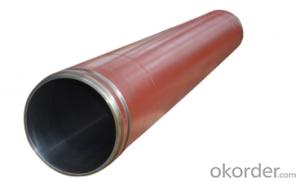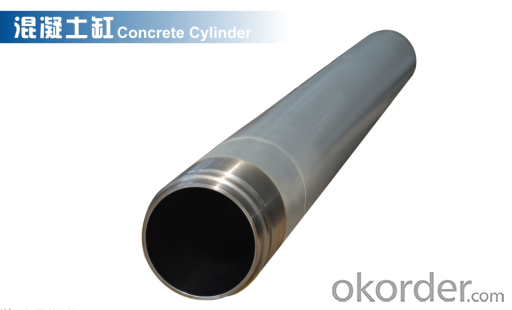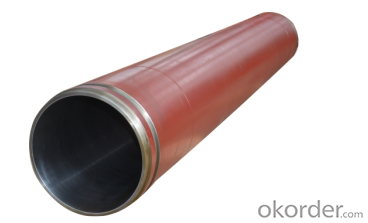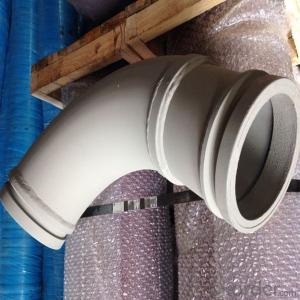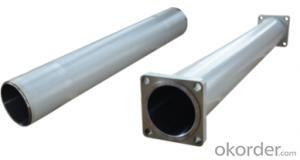DELIVERY CYLINDER(ZOOMLION ) I.D.:DN200 CR. THICKNESS :0.25MM-0.3MM COLOR:WHITE LENGTH:1787MM
- Loading Port:
- Shanghai
- Payment Terms:
- TT OR LC
- Min Order Qty:
- 2 pc
- Supply Capability:
- 1000 pc/month
OKorder Service Pledge
Quality Product, Order Online Tracking, Timely Delivery
OKorder Financial Service
Credit Rating, Credit Services, Credit Purchasing
You Might Also Like
Packaging & Delivery
| Packaging Detail: | wooden case, seaworthy packing |
| Delivery Detail: | 15 days |
Specifications
Concrete Pump Delivery Cylinder DN200*1787
1. Capacity: 60,000~80,000cbm
2. Size: DN180, DN200, DN230..
4. Brand: PM, Sany,ZM
Concrete Pump Delivery Cylinder DN200*1787
1. Material: C45
2. quenching and tempering to improve the hardness to HB241-280
3. inner wall chrome thickness is 0.25-0.30mm, hardness HV820-900.
4. Brand: SCHWING, PM, SANY, KYOKUTO, CIFA
5. Capacity: 60,000~80,000cbm
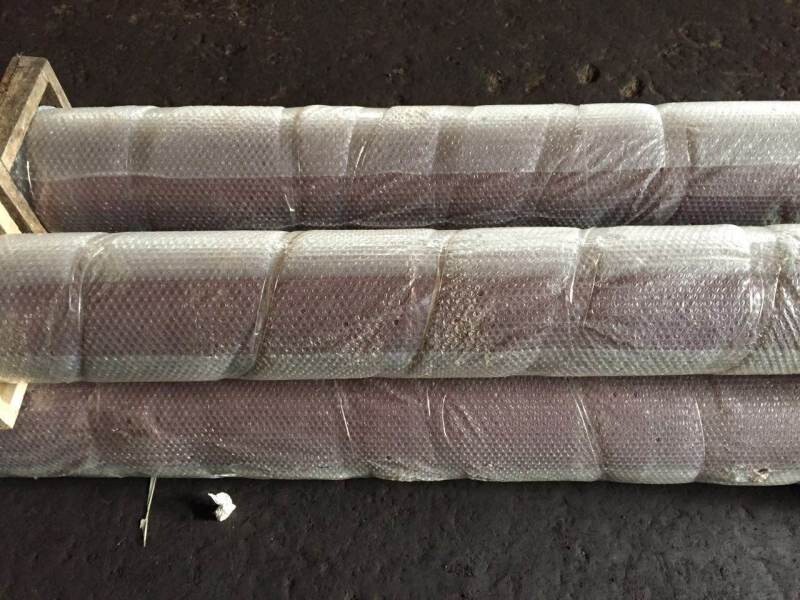


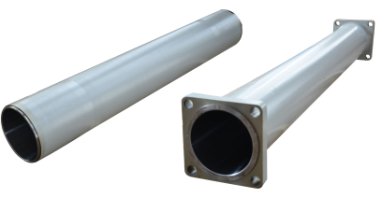
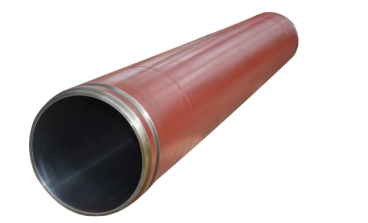
- Q: How often should concrete pump pistons be inspected and replaced?
- To ensure optimal performance and prevent malfunctions, it is necessary to regularly inspect and replace concrete pump pistons. The frequency of these inspections and replacements depends on various factors, such as the type and volume of concrete being pumped, as well as the operating conditions of the pump. As a general rule, it is recommended to inspect and replace concrete pump pistons every 500 to 1,000 hours of operation. However, this can vary based on the specific recommendations of the pump manufacturer, the quality of the concrete being pumped, and the maintenance and cleaning practices followed. Regular inspections should be conducted to identify any signs of wear, damage, or deterioration in the pistons. This includes examining the rubber seals, valve plates, and other components that may impact the piston's performance. If any cracks, tears, or excessive wear are detected, immediate replacement is necessary to prevent issues like concrete leakage or pressure loss. In addition to regular inspections, it is essential to follow a preventive maintenance schedule that includes routine cleaning and lubrication of the pistons. This will help extend their lifespan and ensure smooth operation. It is important to note that the recommended intervals for inspection and replacement may vary among different pump manufacturers. Therefore, it is advisable to consult the pump's operation and maintenance manual or seek guidance from the manufacturer or a qualified technician to determine the ideal frequency for inspecting and replacing concrete pump pistons.
- Q: How can one ensure compatibility between concrete pump spare parts and the pump?
- Ensuring compatibility between concrete pump spare parts and the pump is crucial to maintain the efficiency and performance of the equipment. Here are a few steps to ensure compatibility: 1. Identify the correct model and manufacturer: Gather all the necessary information about the concrete pump, including the model number and manufacturer. This information will help you find the right spare parts that are specifically designed for that particular pump model. 2. Use genuine spare parts: It is always recommended to use genuine spare parts provided by the pump manufacturer or authorized distributors. Genuine parts are specifically designed and tested to meet the pump's specifications, ensuring a perfect fit and compatibility. 3. Check part numbers and specifications: Before purchasing any spare parts, carefully cross-check the part numbers and specifications with the original parts. This will help ensure that the new parts are compatible with the pump. 4. Consult with experts: If you are unsure about the compatibility of certain spare parts, consult with experts or the manufacturer's technical support team. They can provide guidance and advice based on their expertise and experience. 5. Conduct regular maintenance and inspections: Regularly inspect and maintain the concrete pump to identify any wear or damage to the parts. This will help you identify the specific spare parts that need replacement and ensure compatibility with the pump. 6. Prioritize quality and reliability: While cost may be a factor, it is important to prioritize quality and reliability when choosing spare parts. Investing in high-quality parts will ensure better performance, durability, and compatibility with the pump. By following these steps, you can ensure compatibility between concrete pump spare parts and the pump, thereby maximizing its lifespan, performance, and overall efficiency.
- Q: How often should control system sensors be calibrated or replaced?
- The frequency at which control system sensors should be calibrated or replaced depends on several factors. These factors include the type of sensor, its application, environmental conditions, and the manufacturer's recommendations. In general, it is recommended to calibrate control system sensors at least once a year. However, certain sensors may require more frequent calibration due to their sensitivity or criticality in the system. For example, sensors used in safety-critical applications or those that are exposed to harsh environmental conditions may need to be calibrated more frequently, such as every six months or even quarterly. Additionally, it is important to monitor the performance of control system sensors regularly to ensure accurate readings and reliable operation. This can be achieved through routine maintenance and periodic checks. If any signs of sensor drift, inconsistency, or failure are observed during these checks, immediate calibration or replacement may be necessary. Moreover, the manufacturer's recommendations play a significant role in determining the calibration or replacement intervals. Each sensor has its own specifications and guidelines provided by the manufacturer. It is essential to follow these recommendations to maintain optimal performance and extend the lifespan of the sensor. Ultimately, the calibration or replacement frequency of control system sensors should be determined by a combination of factors including industry standards, application requirements, environmental conditions, and manufacturer's guidelines. Regular monitoring, routine maintenance, and adherence to these factors will ensure that control system sensors operate accurately and reliably.
- Q: What is the purpose of a concrete pump remote control battery?
- The purpose of a concrete pump remote control battery is to provide power and mobility for the remote control device used to operate a concrete pump. The remote control allows the operator to conveniently control the movements and functions of the concrete pump from a distance, without having to be physically present at the pump itself. The battery supplies the necessary electrical energy to the remote control, enabling it to transmit signals and commands wirelessly to the concrete pump. This allows for greater flexibility and ease of operation, as the operator can move around the construction site while maintaining control over the concrete pump. The battery also ensures uninterrupted operation of the remote control, allowing for efficient and accurate control of the concrete pump's functions.
- Q: What are the different types of concrete pump rubber hoses?
- There are several different types of concrete pump rubber hoses available, including wire-reinforced hoses, fabric-reinforced hoses, steel wire braided hoses, and composite hoses. These hoses are designed to withstand the high pressure and abrasive materials involved in pumping concrete, ensuring safe and efficient operations.
- Q: How often should hydraulic filters be replaced in a concrete pump?
- Hydraulic filters in a concrete pump should be replaced on a regular basis to ensure optimal performance and longevity of the equipment. The exact frequency of replacement will depend on various factors such as the specific model of the concrete pump, the operating conditions, and the quality of hydraulic fluid used. As a general guideline, it is recommended to replace hydraulic filters in a concrete pump every 500 to 1,000 operating hours or at least once a year, whichever comes first. However, it is essential to refer to the manufacturer's recommendations and guidelines for the specific model of the concrete pump, as they may have specific maintenance schedules and intervals. Regular inspection of the hydraulic filters is also crucial to determine if replacement is necessary sooner than the recommended interval. If the filters are clogged, damaged, or show signs of excessive wear, they should be replaced immediately to prevent any potential damage to the hydraulic system. Additionally, if the concrete pump is operating in harsh or dusty environments, the filters may need to be replaced more frequently to ensure proper filtration and prevent contamination. Overall, proper and timely replacement of hydraulic filters in a concrete pump is essential to maintain the efficiency and reliability of the equipment, prevent potential breakdowns, and extend its service life.
- Q: How often should hopper cylinder seals be replaced in a concrete pump?
- Hopper cylinder seals in a concrete pump should be replaced as soon as signs of wear or damage are observed. Regular inspection and maintenance can help identify the need for replacement, but the frequency ultimately depends on factors like usage, environmental conditions, and the quality of the seals. It is recommended to follow the manufacturer's guidelines and consult with professionals to determine the appropriate replacement schedule for hopper cylinder seals in a concrete pump.
- Q: Are there any specific guidelines for the storage and handling of concrete pump spare parts during transportation?
- Yes, there are specific guidelines for the storage and handling of concrete pump spare parts during transportation. These guidelines include ensuring proper packaging and labeling of the spare parts, using appropriate containers or packaging materials to protect them from damage, securely fastening and securing the spare parts to prevent movement during transit, and following any specific instructions provided by the manufacturer for handling and storing the spare parts. It is also important to consider factors such as temperature, humidity, and potential hazards during transportation to ensure the integrity and quality of the spare parts.
- Q: What is the first generation pumping technology of concrete pump?
- Electronically controlled reversing technology, PLC control solenoid valve reversing to achieve the pump, S pipe distribution of alternating direction
- Q: What are the potential risks associated with the installation and replacement of concrete pump spare parts?
- There are several potential risks associated with the installation and replacement of concrete pump spare parts. One of the main risks is the possibility of improper installation. If the spare parts are not installed correctly, it can lead to issues such as leaks, decreased performance, and even equipment failure. This can not only result in costly repairs but also pose a safety hazard to workers and those in the surrounding area. Another potential risk is the use of counterfeit or low-quality spare parts. These parts may not meet the necessary standards and specifications, which can compromise the integrity and functionality of the concrete pump. This can also increase the risk of equipment failure and accidents. Additionally, the installation and replacement process may require workers to operate heavy machinery, such as cranes or forklifts, which can be hazardous if not done properly. There is a risk of accidents, injuries, or damage to the equipment or surrounding structures if adequate precautions are not taken. Furthermore, concrete pump spare parts may contain hazardous materials or substances. Workers need to be aware of the potential risks associated with handling and disposing of these materials, such as exposure to harmful chemicals or environmental contamination. Lastly, there is a risk of delays and downtime during the installation and replacement process. If spare parts are not readily available or if there are issues with their compatibility, it can result in extended periods of equipment inoperability. This can lead to project delays, increased costs, and potential financial losses. To mitigate these risks, it is important to ensure proper training and supervision of workers involved in the installation and replacement of concrete pump spare parts. Using genuine and high-quality spare parts from reputable suppliers can also reduce the risk of equipment failure. Regular inspections, maintenance, and adherence to safety protocols are crucial to minimize the potential risks associated with this process.
Send your message to us
DELIVERY CYLINDER(ZOOMLION ) I.D.:DN200 CR. THICKNESS :0.25MM-0.3MM COLOR:WHITE LENGTH:1787MM
- Loading Port:
- Shanghai
- Payment Terms:
- TT OR LC
- Min Order Qty:
- 2 pc
- Supply Capability:
- 1000 pc/month
OKorder Service Pledge
Quality Product, Order Online Tracking, Timely Delivery
OKorder Financial Service
Credit Rating, Credit Services, Credit Purchasing
Similar products
Hot products
Hot Searches
Related keywords

